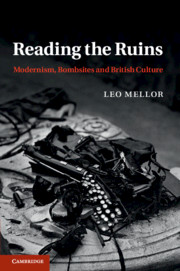Chapter 1 - Imagining destruction
Published online by Cambridge University Press: 07 October 2011
Summary
We realised that London was suffering a terrible visitation from above.
William le Queux, The Terror of the Air (1920)I told you so. You damned fools –
H. G. Wells, preface to the 1941 edition of The War in the Air (1908)Within the longer history of imagining the ruination of the city, both as a pleasure and a terror, stretching back through Troy, Alexandria and Rome, British late Victorian literature was highly detailed and specific. Its combinations of war fear and war lust drew heavily on conceptions of death from above, combining metaphors for heavenly vengeance with the model of totalising omnipotence offered by the Royal Navy. Even before credible aircraft flew, works such as William D. Hay’s Three Hundred Years Hence (1881) feature the unleashing of ‘a rain of awful death to every breathing thing’ from aeroplanes to ‘subjugate the inferior races’; while in Samuel Odell’s The Last War, or the Triumph of the English Tongue (1898) thousands of airships, laden with bombs and a form of ur-Napalm, wipe out French and German cities. Tom Harrison, many years later, commented astutely on the hyper-inflation of possible destruction in such works: ‘Air-power was born with a kind of huge attachment, a Siamese twin, so that the facts of the matter were intimately blended with an almost separate, quite identifiable other form called Fear-Fantasy.’
The British War Office publication, issued in 1905, The Manual of Military Ballooning conflated a directly plausible military use of balloons for observation and reconnaissance with the future possibility that dropping gun cotton charges might have a ‘moral[e] effect’ on the enemy. But any conflict of manoeuvre was assumed to be land- or sea-based: the possibilities of aerial attack were limited by miniscule payloads and the vagaries of the weather. The imaginative potential of war being extended into another dimension did, however, start to make an appearance, and especially so in a medium itself as new as flight – film. The peril from above had to be anchored down by narrative decencies – through, for example, a compliant heroine and proto-boffin embracing at the close of The Battle of the Clouds (1909). Yet these generic elements appear oddly sinister as its depictions of a city engulfed in voracious flames is only partially offset by the subplot hinted at in its subtitle: A Love Story of the Inventor of the Aerial Torpedo. Contemporary to this is The War in the Air (1908), H. G. Wells’ attempt to extrapolate technological prowess and insert picaresque tangents in his imagined world war fought from airships. In it the cities are vulnerable and without defence – and it is the Germans that, plausibly, have the upper hand. In Wells’ work – a ‘fantasia of possibility’ – the ‘moral effect’, explained in the Military Ballooning Manual and determined by the War Office at great length, is seen in the movements of masses and totalising destruction.
- Type
- Chapter
- Information
- Reading the RuinsModernism, Bombsites and British Culture, pp. 11 - 46Publisher: Cambridge University PressPrint publication year: 2011
- 1
- Cited by

